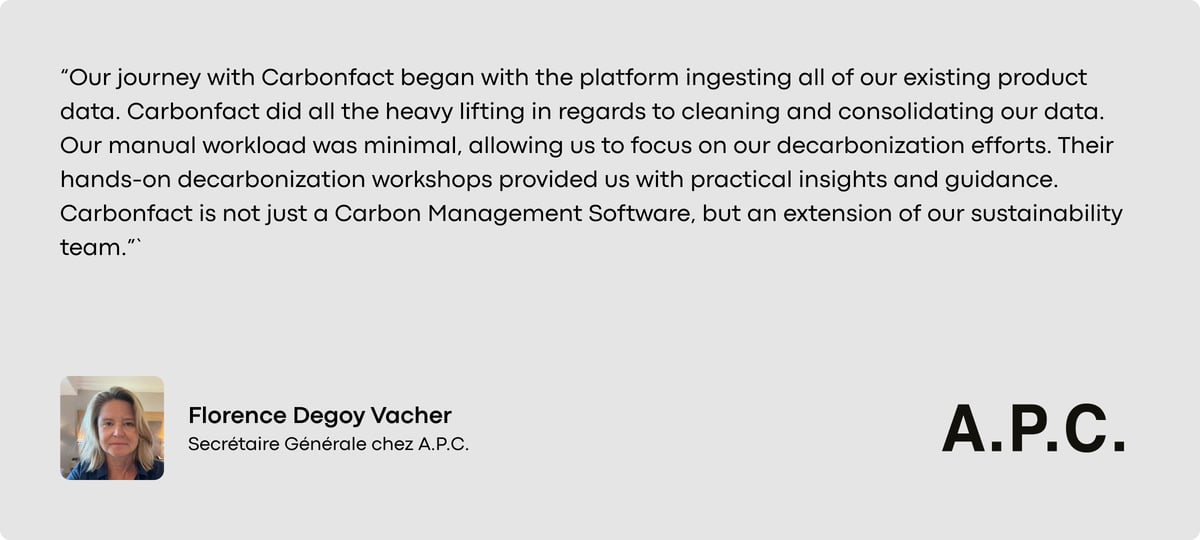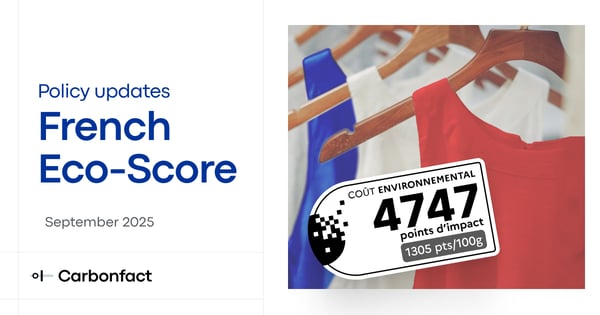Learn how Carbonfact helped A.P.C. easily assess the environmental footprint of their entire collection and enabled their sustainability, design, and production teams to develop strategic plans for reducing their carbon footprint.
 *All quotes in this case study are attributed to Florence Degoy Vacher, Secrétaire Générale chez A.P.C.
*All quotes in this case study are attributed to Florence Degoy Vacher, Secrétaire Générale chez A.P.C.
About A.P.C.
A.P.C. is a French clothing brand renowned worldwide for the creativity, authenticity, and durability of its products. While the name A.P.C. is associated with raw denim, the brand offers a wide range of clothing and accessories for women and men looking in search of bold styles that won’t overshadow their personalities.
Convinced that fashion must be eco-responsible and mindful of the social fabric, A.P.C. has implemented a number of concrete initiatives to improve its environmental footprint and ethical responsibility. Since its inception, A.P.C. has used natural fibers, raw denim, organic cotton, and recycled cashmere, whenever possible.
Interview with Louise Vandon, CSR Officer at A.P.C.
The Limits of Generic Carbon Accounting Solutions
“Our previous carbon accounting solution wasn’t able to provide insights into the footprint of the different manufacturing steps of our clothes and bags. For example, we couldn’t see that textile formation has such a big impact on the carbon footprint. It also relied primarily on secondary data, which prevented us from building concrete decarbonization plans for our brand.”
Decarbonizing the supply chain requires a deep understanding of your product’s carbon footprint and the tools and expertise to model potential reductions effectively.
French fashion brand A.P.C. found it difficult to obtain accurate and detailed measurements of its carbon emissions with its generic carbon accounting platform. The platform's reliance on mostly secondary data hindered the brand's ability to accurately assess its carbon footprint and identify areas for improvement.
Additionally, the previous platform's lack of granularity in terms of apparel-specific manufacturing steps prevented A.P.C from conducting meaningful what-if simulations to evaluate the impact of potential changes to its supply chain or operations.
Beyond Generic Metrics: Seeking a Carbon Management System Tailored for Fashion
“We needed a solution that could handle the complexities of the apparel supply chain, provide year-to-date insights, and support with detailed scenario analyses for our supply chain. This shift was not just about tracking emissions in a more precise way; it was about empowering our team with the right tools and expertise to make informed decisions."
A.P.C. decided to search for a more comprehensive carbon management solution specifically tailored to the apparel industry, with the following criteria:
- A vendor that would do the heavy lifting when it came to data ingesting, minimizing the effort time needed from the A.P.C.’s sustainability team
- A platform that provided instant insights and year-to-date footprint trend reports, not just yearly, backward-looking information
- A tool that could provide granularity for Scope 3 emissions, by ingesting primary data from the brand, such as energy usage data from specific suppliers
- A company that could provide expert guidance on SBTi and how to develop a decarbonization roadmap
Choosing Carbonfact: Integrating primary data to build detailed decarbonization plans
"Adopting Carbonfact enabled A.P.C. to integrate primary data from various internal platforms, enabling us to get life cycle assessments for our complete product catalog. This transition allowed us to conduct more precise carbon accounting and leverage the Product Modeling tool for detailed what-if analyses. Through scenarios such as switching materials and changes in transport, we've identified several impactful strategies to lower our emissions. “
Unlike their previous tool, Carbonfact could ingest primary data from the A.P.C’s different platforms (such as Centric, Fairlymade, and their ERP), and transform it into detailed and accurate life cycle assessments for all their products. Not only does this mean that A.P.C. can conduct a more precise GHG Carbon Accounting, but it also enables the team to make use of Carbonfact’s Product Impact Simulation tool.
Their sustainability team can collaborate with design and production teams experimenting with different materials and components, suppliers, or transportation methods to see how the changes would impact their emissions. For instance, they can assess the potential carbon savings associated with switching from air freight to ocean shipping. Additionally, by modeling scenarios like replacing 100% wool with a blend of 20% recycled and 80% virgin wool, they can identify low-impact alternatives for their products. This granular analysis empowers A.P.C. to make informed decisions that will reduce their carbon footprint.
More than just a carbon management platform: An extension of the sustainability team
A.P.C's decision to adopt Carbonfact wasn't just about choosing a carbon management platform; it was about finding a partner who could act as an extension of their sustainability team and help them build their decarbonization plans.
Following the hands-on workshops led by Carbonfact’s climate experts with extensive knowledge of the fashion industry, A.P.C. has established clear evaluation criteria for its decarbonization scenarios, assessing CO2 reduction, cost, and feasibility. This will ensure that the decarbonization strategies will not only be effective in reducing emissions but also practical and financially viable. For example, A.P.C. discovered a supplier of recycled wool at a lower price than conventional wool, enabling them to model the emissions reduction potential and cost savings of replacing the wool in all their sweaters.






 Martin Daniel
Martin Daniel

 Lidia Lüttin
Lidia Lüttin
